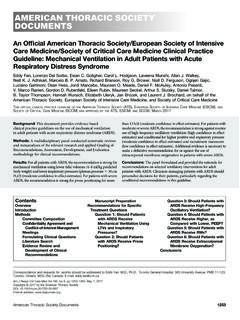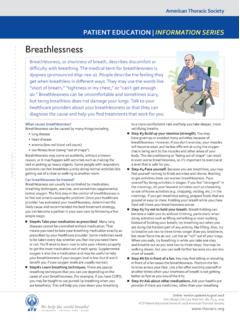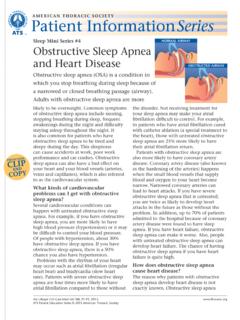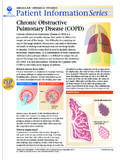Transcription of Malignant Pleural Effusion - American Thoracic Society
1 American Thoracic Society PATIENT EDUCATION | INFORMATION SERIES. Malignant Pleural Effusion A Malignant Pleural Effusion (MPE) is the build up of fluid and cancer cells that collects between the chest wall and the lung. This can cause you to feel short of breath and/or have chest discomfort. It is a fairly common complication in a number of different cancers. What is the Pleural space? common symptoms: Both the lungs and the chest wall are lined with thin Shortness of breath at rest or with activity membranes called pleura'. The lung is typically fully Chest pain or pressure expanded in the chest and comes right up to the chest Cough wall.
2 As such, the normal Pleural space' (the area in Pain when taking a deep breath, or the feeling of not between the lung and the chest wall) only contains a being able to take a deep, satisfying breath small amount of fluid (approximately 1 teaspoon). Fever What is a Pleural Effusion ? Fatigue A Pleural Effusion is an abnormal build-up of fluid in the How do you know if you have a MPE? CLIP AND COPY. Pleural space. Your healthcare provider may first suspect that you have What causes a Pleural Effusion ? a MPE on physical examination. To see if you have a MPE. A Pleural Effusion can be caused by many diseases. It can and estimate how much fluid is present, you will have one be seen in infections and other diseases in addition to or more of the imaging tests: various cancers.
3 In general, fluid builds up in the Pleural space if there is an overproduction of fluid, decreased Chest X-Ray: A picture showing a view of the chest, absorption of the fluid, or both. If the cause of the including the heart and lungs. Effusion is due to cancer cells in the fluid, the Effusion is CT Scan of the Chest: Multiple pictures of the chest called a Malignant Pleural Effusion or MPE. (think of it as a set of bread-loaf slices through the chest) that gives a lot more detail and information than What causes a Malignant Pleural Effusion (MPE) to form? a chest X-ray. An MPE forms when cells from either a lung cancer or Ultrasound of the Chest: One of the best methods of another type of cancer spread to the Pleural space.
4 These imaging the Pleural space. Ultrasound does not involve cancer cells increase the production of Pleural fluid and any radiation and can also be used to help guide cause decreased absorption of the fluid. procedures to sample or drain Pleural fluid. Who can get a Malignant Pleural Effusion ? When a Pleural Effusion is suspected or confirmed , your People with lung cancer, breast cancer, and lymphoma healthcare provider will need to take a sample of the fluid (a cancer of lymphatic tissue) are most likely to get a to see what is causing the Effusion . This can be done in one MPE. Mesothelioma (a rare cancer of the pleura itself) of two ways.
5 Is another common cause of MPE. Other causes of MPE Thoracentesis: This is a simple and safe procedure that include cancer that has spread from the stomach, kidney, is often done in an outpatient setting. Usually you will ovaries, and colon. be sitting up and leaning over a table. The procedure What are the symptoms of a Malignant Pleural Effusion ? is done using local anesthesia medicine to reduce any The symptoms of a MPE can be extremely variable discomfort or pain. Ultrasound is often used to identify and range from having no symptoms in some people a safe place to insert a catheter. The fluid is drained over to being very bothersome in others.
6 Below is a list of several minutes and the catheter is removed. At the end Am J Respir Crit Care Med Vol. 194, P11-P12, 2016. Online version updated April 2021. ATS Patient Education Series 2016 American Thoracic Society American Thoracic Society PATIENT EDUCATION | INFORMATION SERIES. of the procedure, a bandage is placed over the wound hospital with a chest tube in place for a few days. The which then closes on its own without the need for main advantage of this approach is to hopefully prevent stitches. The fluid is tested to determine the cause of the future fluid build-up. You may have a temporary drop in Effusion and look for cancer cells.
7 (For more information your oxygen level and you may need medicine for some see the ATS Patient Information Series Thoracentesis pain for a few days. fact sheet at ) Indwelling Pleural catheter (IPC): This device is a small Thoracoscopy with biopsy: This is a slightly more catheter that is placed under your skin and into the invasive procedure that is generally done for one of Pleural fluid, which allows repeated drainage at home several reasons: (without any more needle sticks) to relieve symptoms. if a thoracentesis does not tell your healthcare These catheters are placed using local anesthesia as an provider the cause of the Effusion .
8 Outpatient procedure. The catheter is safe, easy to use if more tissue is needed to look for molecular and may help allow the lung to eventually expand fully markers'. This will help your oncologist select the up to the chest wall. Once the fluid build-up resolves, best medications to treat the cancer. the catheter can be removed in many patients after 2-3. to do a pleurodesis' (a procedure used to get the months. The main disadvantage of the IPC is the need to lung to stick up to the chest wall see below). care for the catheter (which is not that difficult). For more Thoracoscopy (often referred to as VATS video assisted information, see the ATS Patient Information Series fact thoracoscopic surgery or medical pleuroscopy') is done sheet on indwelling Pleural catheters at under moderate sedation or general anesthesia.
9 Your Authors: Roy Semaan MD, David Feller-Kopman MD, physician will make a small incision on your side between Christopher Slatore, MD, MS and Marianna Sockrider, MD, DrPH. the ribs, the fluid is drained out of the space and a camera Reviewer: Charles Powell, MD, Rosemary Adamson, MBBS. is inserted into the chest cavity to visually examine the pleura and take biopsies to send for analysis under a microscope. In certain cases, this can be performed as an R Action Steps outpatient procedure, however your healthcare provider Malignant Pleural effusions are a common complication may want to have you stay in the hospital for at least one in some forms of cancer.
10 Day observation. If you have breathing problems with cancer, talk to your healthcare provider to see if you have developed a MPE. How are Malignant Pleural effusions treated? Your cancer specialist will help you decide what the best Medical oncologists (specialists who treat cancer) and approach may be for you to treat the symptoms of MPE. radiation oncologists may treat the underlying cancer and decrease the chance of it coming back. with chemotherapy, immunotherapy and/or radiation Healthcare Provider's Contact Number: to prevent the fluid from accumulating. Your lung doctor (pulmonologist) or Thoracic (chest) surgeon will work with your oncology team to discuss several other treatments currently available to remove the fluid and/or prevent it from re-accumulating (building back up) with the goal Additional Resources: of keeping you breathing well.











